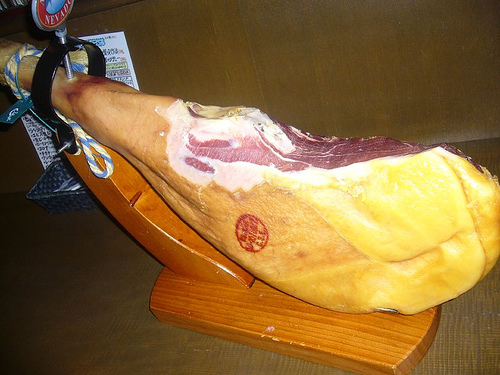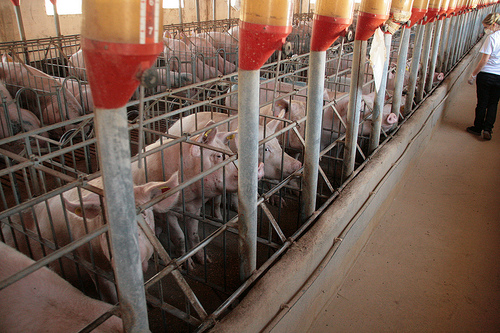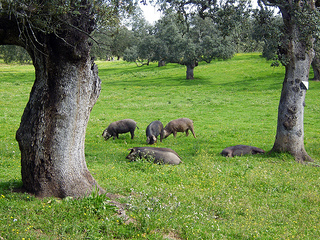Differences Between Iberico Ham and Serrano Ham
For avid Spanish ham fans, it should not be hard to tell whether you're looking at a good ham or not. But you might wonder whether you're dealing with an Iberico ham or a Serrano ham.
What real difference is there between the two, and where did those differences come from? Is Serrano a special breed? Are the pigs fed differently for the two types of Spanish ham? Why would you choose one over the other?
Iberico ham and Serrano ham: appearances are deceptive
While it might seem that we're talking about two very similar products, especially at first glance, in fact there's a large difference between Iberico and Serrano ham, with the two having very different aromas, flavors, colors and textures.
This despite the fact that ultimately, a leg of pork is the origin of both products.
Differences in the breeds of pigs used, the curing methods and the feeding regime of the pigs all contribute to this divide.
The sensory properties of Iberico and Serrano ham
In short, these organoleptic properties to which we refer are the aroma, flavor, color and texture of the Spanish ham. Using these, we can establish some of the most important differences between Iberico and Serrano ham.
In terms of aroma, all experts agree that Iberico ham has a unique aroma that is hard to miss and even harder to mistake for anything else.
There are clear color differences too: Serrano tends to be a pinkish color, in contrast to the deep bright red of Iberico ham.


In terms of flavor, a good Iberico ham is distinguished by a more intense falvour and a juicier texture, due to the quality of intramuscular fat present in the ham.
Meanwhile, the Serrano equivalent tends to have a saltier flavor. Finally, Serrano tends to a less juicy texture due to a lower proportion of intramuscular fat, and Iberico tends to have a more rugged texture.
However, we don't need to taste or feel a Spanish ham to know whether it is Iberico or Serrano. We can distinguish at a glance if we know what to look for.
Iberico is typically a longer ham with an elongated shape and a narrower bone, and typically ends on a black hoof. If you can't tell by looking at the ham directly, look at the price: Iberico is much the more expensive of the two types, with its increased quality reflected in a larger price tag.
A question of genes
The main difference between Iberico and Serrano ham is the origin of the raw material - the type of pork that's used. Iberico ham has to come from pigs that are at least 50% certified Iberico breed, and can only be mixed with one other breed: White Duroc.
The highest quality Iberico ham is considered to come from 100% Iberico pigs. This breed is black with a long snout and has little fur, and is genetically predisposed to storing up fat between its muscles, meaning that when it's hung to cure the flavor from the fat is absorbed into the muscles.
This is just one reason for its popularity.
Meanwhile, when we speak of Serrano ham, we can see that we're referring to any non-Iberico pig breed. Serrano can be made from mixed-breed pigs with a small amount of Iberico blood, but it's more usually made from White Duroc, Large White, Landrace and Pietrain.
The importance of the feeding regime
Another factor is the feeding regime. Iberico ham is considered to be 'graded' based on what the animal has been fed and fattened on, with the 'montanera' ('mountain pasture') regime resulting in the best flavor and most prestigious product.
This means the pigs have been reared and fed in mountain pastureland, eating wild grasses and acorns, resulting in the 'bellota' flavor that characterizes the very best Iberico ham.
Meanwhile, lower-quality hams come from pigs fed more modern diets including grains.


The origins of Iberico and Serrano ham
When we speak of Serrano ham, we're talking about non-Iberico pigs reared intensively and fed lower-quality diets focussed on mass rahter than flavor in the fattening period before slaughter.
This means that the flavor cannot compare to Iberico pigs reared and fattened in traditional open pastures.
However, Serrano hams are graded based on quality too, with the grades being 'bodega' (cellar), Reserve and Grand Reserve. The term 'serrano' refers to the process of curing the ham in the dry, cold air of a mountain climate.
The consumer who wishes to purchase either product will have no difficulty in identifying, through labelling, the origin, breed, feeding regime and quality of the majority of Spanish hams on the market. (All those sold through Jamonprive are labelled clearly.)
There are four main designations for the origins of Iberico hams: Guijuelo, Dehesa de Extremadura, Huelva and Los Pedroches. Meanwhile, the best-known Serrano hams come from Salamanca, Teruel or Trévelez, though they are produced virtually across the entire Iberian peninsula.
Todo sobre el jamón
Contenido
- 1 Tipos de jamón ibérico
- 2 Cómo consumir jamón ibérico
- 3 Cortar jamón ibérico
- 4 Cómo conservar el jamón ibérico
- 5 Maridaje del jamón ibérico
- 6 Ley de calidad del jamón ibérico
- 7 La Dehesa
- 8 Denominaciones de origen del jamón ibérico
- 9 Propiedades nutricionales del jamón ibérico de bellota
- 10 Recetas con jamón
- 11 Diferencias entre jamón ibérico y jamón serrano
- 12 Diferencias entre paletilla y jamón ibérico
- 13 Diferencias entre jamón ibérico y jamón serrano
- 14 Jamón ibérico y sus competidores en el mundo
- 15 Propiedades nutricionales del jamón ibérico
- 16 Denominación de origen del jamón ibérico
- 17 Zonas de elaboración del jamón y del jamón pata negra
- 18 Jamón cortado a mano o a máquina
- 19 Museos del jamón ibérico en el mundo
- 20 Cata de jamón ibérico: todos los secretos
- 21 Ruta del jamón ibérico
- 22 El jamón ibérico de bellota y su maridaje ideal
- 23 Proceso de elaboración de los embutidos ibéricos
- 24 Historia de los embutidos ibéricos
- 25 IVA para el jamón: preguntas y respuestas
- 26 El jamón en la literatura
- 27 Curiosidades del jamón ibérico
- 28 Cómo conservar el jamón serrano
- 29 Normativa de calidad del jamón serrano
- 30 Elaboración del jamón serrano
- 31 Denominaciones de origen del jamón serrano
- 32 Propiedades nutricionales del jamón serrano
- 33 Recetas con jamón serrano
- 34 Tipos de jamón serrano
- 35 Maridaje del jamón serrano
- 36 Cómo consumir jamón serrano
- 37 Cortar jamón serrano
- 38 Todos los secretos sobre la cata de jamón pata negra
- 39 Cómo elegir un buen soporte jamonero
- 40 Cuál es el mejor jamón pata negra?
- 41 Es correcto el término jamón pata negra?
- 42 Jamón pata negra y dehesa
- 43 Los secretos del maridaje del jamón pata negra
- 44 ¿Cómo saber qué jamón comprar?
- 45 ¿Por qué el buen jamón es tan caro?
- 46 ¿Cómo comprar jamón en tiendas online?
- 47 Mitos y realidades, beneficios y prejuicios del jamón
- 48 ¿El jamón ibérico engorda?
- 49 ¿Qué hacemos con el hueso del jamón?
- 50 ¿Por qué solemos colgar el jamón?
- 51 Jamón y embarazo: ¿Se puede incluir el jamón ibérico en la dieta de las embarazadas?
- 52 El rol del jamón en el crecimiento y desarrollo de los niños
- 53 Consejos para conservar el jamón
- 54 ¿Qué es el perfilado del jamón y por qué se hace?
- 55 Nuevas tecnologías y jamón - Resonancia magnética en la cata del jamón - Imágenes espectrales
- 56 El cerdo ibérico comienza a emigrar
- 57 Embutidos: Origen, composición y clasificación
- 58 Elaboración de jamones y paletas
- 59 Guía de Cata del Jamón Ibérico
- 60 Elementos diferenciales de calidad en jamón y embutidos “ibéricos”
- 61 El mapa del jamón en España
- 62 Propiedades de la grasa del jamón ibérico
- 63 Cómo transportar jamón ibérico y otros alimentos en vuelos internacionales
- 64 Prevalencia de patógenos y beneficios de los ácidos orgánicos en la producción de cerdos




